Phosphates: pyromorphite
 Diagnostic Card.
Diagnostic Card.
In the photo: a sample of Pribram in Bohemia.
Pb 5 (PO 4)3 Cl
Crystal system hexagonal
Hardness of 3.5-4
Specific weight 6,7-7
Cleavage is absent
fracture conchoidal
Colour colorless, raznookra- Weighted
Color white powder
Gloss of the diamond to the resin
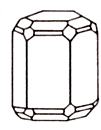
Pyromorphite - lead chloride phosphate. Diamond Gloss to fat, it shines. Colors: green, blue-green, yellow, brown, white: is colorless (depending on the color it is called green, brown or mottled lead ore). Dash white to yellow. Fracture conchoidal, uneven. Fragile. Cleavage is absent. Formed in the zone of sulfide oxidation polymetallic deposits. The crystals (hexagonal system) or columnar tolstotablitchatye. Aggregates - grozdevidnye, kidney-shaped, and brown and raids. Often forms pseudomorphs after cerussite and galena. An important ore of lead.
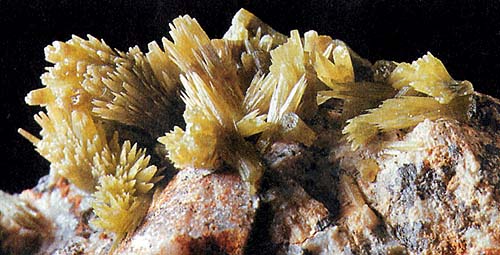 pyromorphite crystals are not too diverse in form, but very common. Usually pyromorphite individuals presented a clear prismatic shape, or elongated or short. Sometimes there are rounded, with members inside faces pitted with small cavities.
pyromorphite crystals are not too diverse in form, but very common. Usually pyromorphite individuals presented a clear prismatic shape, or elongated or short. Sometimes there are rounded, with members inside faces pitted with small cavities.
Completion of the crystals is usually flat, but sometimes spiky. The mineral can also form a group ( "toothbrush") subparallel small prismatic crystals or small clusters of massive globular, branched radiant and reniform structure; There are blotches and brown.
The color of the most diverse: in addition to a very different shades of green are colors yellow, orange, brown, gray; many completely colorless or white varieties pyromorphite. The powder is always white. Gloss ranges from the diamond to the resin. Almost always long prisms, often needle-like, arranged parallel or radially; often accrued, rarely with two heads; large samples composed of several small; often have a barrel-shaped appearance ( "Ems kegs"); spherical, acinar, granular aggregates.
Chemical composition. lead oxide (PbO), 81.7% phosphorus pentoxide (P2O5) 15,7%, chlorine (Cl), 2.6%; calcium impurities, arsenic and chromium. Form crystals. Prismatic, columnar, similar to the apatite crystals. Class symmetry. Hexagonal bimramidalny - 6 / m. Cleavage. Virtually absent. Reniform aggregates, grozdevidnye, dense, solid masses, korotkoluchistye splices.
Diagnostic features.
Soluble in nitric acid. The candle flame is easily melted, forming a ball. Easy fused into a ball on the corner of leaves yellow plaque. Behavior in acids. It dissolves in HNO3. From mimetezita can only be distinguished by chemical analysis.
Origin.
Pyromorphite - a secondary mineral formed in the oxidation zone of lead deposits. It also found its pseudomorphs after other minerals of lead, such as galena and cerussite. Secondary mineral galena deposits. Pyromorphite long it has been known as lead ore. Most of the fields are now produced.
Deposits and application.
As a common mineral, pyromorphite marked in many places in Italy. Among them Falo and Monte Alpe Pirio commune Zhinese near Stessa (province of Verbania), where there were elongated crystals of intense green color. In Val Brembane (in Bergamasco) found crystal inclusions, fairly extensive, with a greenish-yellow color. Absolutely amazing samples found in an abandoned mine near Chinkvevalli Roncenay (Valsugana, Province of Trento) in the mines area of Cagliari.
The most famous European places, of which there were beautiful specimens: Yuce (France); Bad Ems near Koblenz in Germany; Ledhills in Scotland, Pribram in Bohemia (Czech Republic), Birch and Nerchinsk (Russia). Pyromorphite almost not used in the industry; but for collectors of great interest thanks to the beauty of many of its copies.
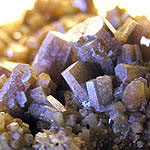
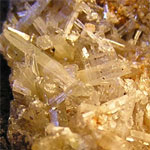
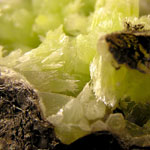



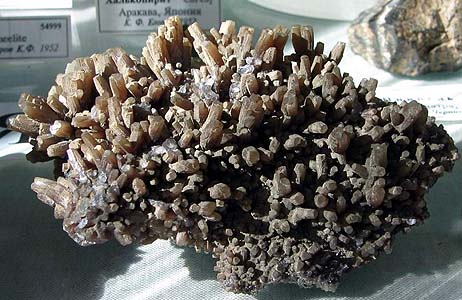
Pyromorphite. Brush crystals to 1cm - a fragment inlaid cavity hornfelsed breccia rocks. The sample size of 7 cm. Yangshuo City district, 60 km south of the city of Guilin, Guangxi Province., China. Pyromorphite. Broken Hill, NJ Wales, Australia. Photo: © AA Evseev.
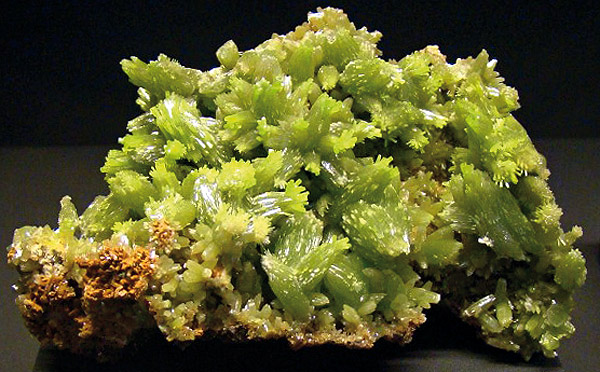
Pyromorphite, China

Pyromorphite, China
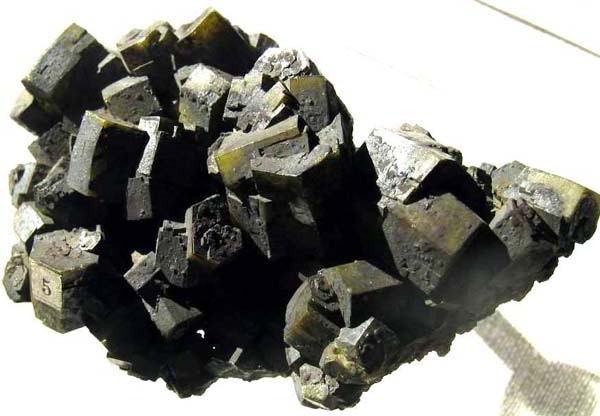
Pyromorphite. Fridrihszegen near Bad Ems, Germany. The crystals up to 1-2 cm Photo:. © AA Evseev.

Pyromorphite. Madjarovo, Bulgaria. 6 cm Photo:. © VA Sletov.
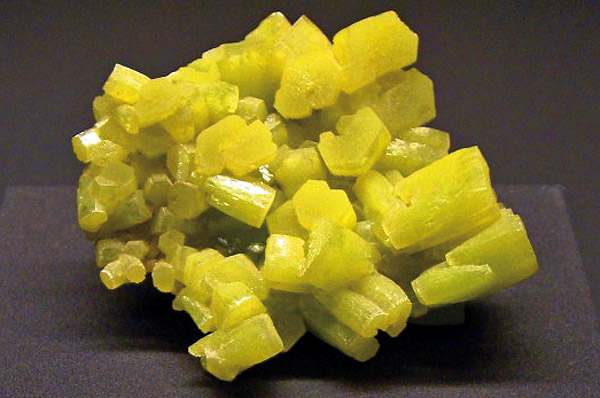
Pyromorphite, China
Lead is a carcinogen and teratogen in humans. It is vital, because the effect on protein synthesis, the energy balance of the cell and its genetic apparatus, is involved in the metabolism of bone tissue and gonads. In normal bone (cartilage and soft tissue), the lead content of 20 mg / kg in the liver - 1 mg / kg, kidney - 0.8 mg / kg, brain - 0.1 mg / kg. In males (gonads), the lead content in the body is higher than in women.
The human body contains 2 mg of lead. In the gastrointestinal tract is absorbed 10.5% (and up to 50%). The degree depends on its solubility compounds. A large amount of lead can occur through the inhalation air (up to 70% of an aerosol containing lead, is deposited in the lungs). At high concentrations, risk arises tetraethyl lead absorption through the skin. Displays lead excreted in the feces (80-90%), and a smaller part of the urine.
Lead deficiency reduces experimental animal growth, gives iron metabolism alters the action of certain enzymes and the concentration of certain metabolites in the liver associated with the iron status. Lead improves growth and increases the hematocrit and hemoglobin concentration in iron deficiency in rats, this effect was due to the pharmacological action of lead. The mechanism by which the lead influences the metabolism of iron - catalyst. Lead is required: at reduced hematocrit and hemoglobin in iron deficiency states.
For all the regions of Ukraine and Russia (CIS), lead is toxic anthropogenic element from the group of heavy metals. This is due to high pollution and emissions of exhaust gases of motor transport running on leaded petrol. From 5% to 30% of the population in urban areas suffer from an excess of lead. In acute lead intoxication observed neurological symptoms, lead encephalopathy, "lead" colic, nausea, constipation, pain throughout the body, decreased heart rate and increased blood pressure. In chronic toxicity observed irritability, hyperactivity (impaired concentration), depression, decreased the IQ (evaluation index of intelligence), hypertension, peripheral neuropathy, loss or loss of appetite, stomach pain, anemia, nephropathy, "the lead fringe", degeneration of muscles of hands hands, etc.
Manifestations of excess lead: irritability, weakness, fatigue, loss of memory; headache; disorders of the peripheral nervous system (pains in the limbs); the emergence of lead rims on the gums; dental caries, arthropathy, bone disease, high blood pressure, atherosclerosis, abdominal pain (lead colic), spastic constipation; exhaustion, weight loss, weight loss, disorders of porphyrin metabolism (urobilinogen, coproporphyrin), nephropathy, progressive renal failure, sperm motility impairment and the ability to fertilize, reduced potency, reticulocytosis, increasing the number of red blood cells with basophilic stippling, anemia, reduced resistance to infection (especially in children), development saturnism syndrome, reduction of body calcium, zinc, and selenium.
- When the lead concentration in the blood in children 10-20 g / 100 ml of disorders marked.
- With the appropriate concentration of from 20 to 40 g / 100 ml IQ observed decrease.
- When the concentration of blood lead in adults and children from 40 to 60 g / 100 ml is marked anemia and peripheral neuropathy.
- When the concentration of lead in blood of adults from 60-80 g / 100 ml are chronic nephropathy.
- With the appropriate concentration of 80-100 ug / 100 ml noted acute nephropathy.
- At concentrations of 100-120 g / 100 ml - encephalopathy.
The toxic effect is due to the ability of lead to form the large number of anions - ligands, which include the sulfhydryl group of cysteine derivatives, imidazole and carboxyl groups, phosphates. As a result of binding anhydride with lead inhibited protein synthesis and activity of enzymes such as ATPase. Lead violates the synthesis of heme and globin, interfering with porphyrin metabolism, induces defects of erythrocyte membranes. Against the background of deficiency of iron, calcium, phosphorus, magnesium and zinc, the body's ability to absorb lead increases. Sulfur-containing amino acids, vitamins A, C, E, group B, folic acid, nicotinamide, calcium, magnesium, zinc, iron, chromium, phosphorus, selenium, contribute to reduction of lead levels in the body.
- Gatchell - "New Almadén snag" - arsenide and antimony sulfide (modern sulphosalts)
- Antimony - toxic metal (semi-metal) are widely used in industry, medicine and engineering
- Zirconium - a rare and non- metal and dangerous jewel in the oxide and salts
- Gold - yellow dangerous and toxic metal -date and accurate digital cable technology
- Sulphur - a golden-yellow toxic substance and a sign of volcanic activity
- Cadmium - a toxic uncirculated unknown wide range of people silvery metal
- Lead - a poisonous gray simulator silver metal and toxic metal snag
- Arsenic - poison classic medieval and modern poisoners and medicine in medicine
Toxic and hazardous radioactive rocks and minerals
** - Poisonous stones and minerals (obligatory check in chemical laboratory + clear indication of toxicity)
** - Radioactive rocks and minerals (obligatory check on a regular dosimeter + ban on the open sale of radioactivity in the event of more than 24 mR / hour + additional measures to protect the population)
Catalog minerals and gems in groups of the world
** - Poisonous stones and minerals
** - Radioactive rocks and minerals


Comments
Commenting, keep in mind that the content and the tone of your messages can hurt the feelings of real people, show respect and tolerance to his interlocutors, even if you do not share their opinion, your behavior in terms of freedom of speech and anonymity offered by the Internet, is changing not only virtual, but real world. All comments are hidden from the index, spam control.